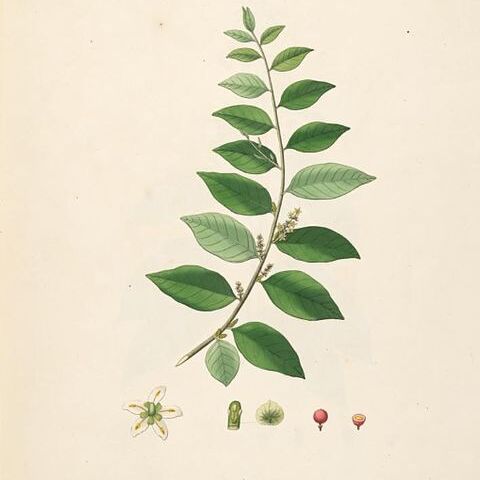Evergreen trees, shrubs, or lianas, root parasites. Stipules absent. Leaves alternate, simple, margin entire, penninerved. Inflorescences axillary or cauliflorous, spikes, racemes, or panicles [or umbels, in Africa]; bracts narrowly ovate or scale-like. Flowers small, actinomorphic, (3-)5-merous, bisexual or unisexual and plants then dioecious or gynodioecious (in Champereia). Perianth free or tepals partly united, valvate. Stamens as many as and opposite tepals, free or filaments inserted on tepals; anthers 2-loculed, introrse, dehiscence longitudinal. Disk intrastaminal, lobed, annular, or cupular. Ovary superior or semi-sunken in disk, 1-loculed; ovule 1, pendulous, unitegmic, tenuinucellar; placentation free-central. Style short or none; stigma entire or shallowly lobed. Fruit a drupe. Seed coat thin; endosperm oily; embryo terete, with 3 or 4 linear cotyledons.
Trees, shrubs, or woody climbers. Leaves alternate, entire, simple, exstipulate. Inflorescence racemose or umbellate. Flowers mainly bisexual but some dioecious (e.g. in Agonandra), but not in Africa, regular. Sepals 4–5, free, valvate, or sometimes partially united. Petals 4–5, free, valvate or sometimes partially united. Stamens opposite and equal in number to the petals, free or partially united to them; anthers dithecous, dehiscing longitudinally. Disk entire or bearing free glands alternating with the stamens. Ovary superior to semi-inferior, unilocular; ovule solitary, pendulous from the apex of a central placenta; stigma sessile or borne on a slender style. Fruit a drupe, often fleshy. Seeds having copious endosperm and a relatively small embryo
Inflorescences racemose or umbellate, axillary, solitary or fasciculate; flowers 4–5-merous, actinomorphic, bisexual, solitary or fasciculate
Stamens as many as the petals and opposite to them, free or united to the base of the petals; anthers 2-celled, opening lengthwise by slits
Ovary fusiform, free or almost so, 1-locular; ovule solitary, anatropous, pendulous from the apex of a central placenta
Ovary superior or semi-inferior, 1-celled; stigma sessile or style slender; ovule solitary, pendulous or erect
Petals conspicuous in bud, 4–5, free or more or less united, valvate
Leaves alternate, simple, entire, penninerved, exstipulate
Seeds with copious endosperm and rather small embryo
Disk with free glands alternating with the stamens
Seed large; endosperm abundant; embryo straight
Leaves alternate, simple; stipules absent
Disk-glands alternating with the stamens
Shrubs, scandent or occasionally erect
Calyx minute, annular or cupuliform
Trees, shrubs or woody climbers
Fruit drupaceous, often fleshy
Flowers mostly hermaphrodite
Stamens opposite the petals
Petals valvate in bud
Fruit drupaceous
Calyx minute

